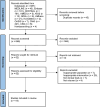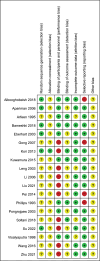Effect of herbal medicine on postoperative nausea and vomiting after laparoscopic surgery: A systematic review and meta-analysis
- PMID: 38847692
- PMCID: PMC11155545
- DOI: 10.1097/MD.0000000000038334
Effect of herbal medicine on postoperative nausea and vomiting after laparoscopic surgery: A systematic review and meta-analysis
Abstract
Background: Traditionally, herbal medicines have been used to alleviate nausea and vomiting; however, a comprehensive clinical evaluation for postoperative nausea and vomiting (PONV), especially after laparoscopic surgery, remains limited. This review aimed to evaluate the efficacy and safety of herbal medicine as an alternative therapy to prevent and manage nausea and vomiting after laparoscopic surgery compared with untreated, placebo, and Western medicine groups.
Methods: We searched 11 databases, including EMBASE, PubMed, and the Cochrane Library, to collect randomized controlled trials (RCTs) of herbal medicines on PONV after laparoscopic surgery on July 7, 2022. Two independent reviewers screened and selected eligible studies, extracted clinical data, and evaluated the quality of evidence using the Cochrane risk-of-bias tool. The primary outcome was the incidence of PONV, whereas the secondary outcomes included the frequency and intensity of PONV, symptom improvement time, antiemetic requirement frequency, and incidence of adverse events. Review Manager Version 5.3. was used for the meta-analysis.
Results: We identified 19 RCTs with 2726 participants comparing herbal medicine with no treatment, placebo, and Western medicine. The findings showed that compared with no treatment, herbal medicine demonstrated significant effects on vomiting incidence (risk ratio [RR] = 0.43, 95% confidence interval [CI] 0.32-0.57, P < .00001). Compared with placebo, herbal medicine revealed a significant effect on the severity of nausea 12 hours after laparoscopic surgery (standardized mean difference = -2.04, 95% CI -3.67 to -0.41, P = .01). Herbal medicines showed similar effects with Western medicine on the incidence of postoperative nausea (RR = 0.94, 95% CI 0.63-1.42, P = .77) and vomiting (RR = 0.68, 95% CI 0.25-1.84, P = .45). Furthermore, comparing the experimental group containing herbal medicine and control group excluding herbal medicine, adverse events were considerably lower in the group with herbal medicine (RR = 0.45, 95% CI 0.27-0.72, P = .001).
Conclusion: Herbal medicine is an effective and safe treatment for nausea and vomiting secondary to laparoscopic surgery. However, the number of studies was small and their quality was not high; thus, more well-designed RCTs are warranted in the future.
Copyright © 2024 the Author(s). Published by Wolters Kluwer Health, Inc.
Conflict of interest statement
The authors have no conflicts of interest to disclose.
Figures













Similar articles
-
Chinese herbal medicine as adjuvant treatment for postoperative nausea and vomiting in patients undergoing laparoscopic surgery: a protocol for systematic review and meta-analysis.BMJ Open. 2023 Jun 28;13(6):e072499. doi: 10.1136/bmjopen-2023-072499. BMJ Open. 2023. PMID: 37380209 Free PMC article.
-
Ginger (Zingiber officinale): An alternative for the prevention of postoperative nausea and vomiting. A meta-analysis.Phytomedicine. 2018 Nov 15;50:8-18. doi: 10.1016/j.phymed.2018.09.007. Epub 2018 Sep 5. Phytomedicine. 2018. PMID: 30466995
-
Dexamethasone versus ondansetron in the prevention of postoperative nausea and vomiting in patients undergoing laparoscopic surgery: a meta-analysis of randomized controlled trials.BMC Anesthesiol. 2015 Aug 15;15:118. doi: 10.1186/s12871-015-0100-2. BMC Anesthesiol. 2015. PMID: 26276641 Free PMC article.
-
Efficacy of Ginger in Preventing Postoperative Nausea and Vomiting: A Systematic Review and Meta-Analysis.J Nurs Scholarsh. 2021 Nov;53(6):671-679. doi: 10.1111/jnu.12691. Epub 2021 Jul 26. J Nurs Scholarsh. 2021. PMID: 34312974
-
The effects of acupressure on postoperative nausea and vomiting among patients undergoing laparoscopic surgery: A meta-analysis of randomized controlled trials.Explore (NY). 2023 May-Jun;19(3):300-309. doi: 10.1016/j.explore.2022.10.015. Epub 2022 Oct 26. Explore (NY). 2023. PMID: 36319586 Review.
References
-
- Kenward H, Pelligand L, Savary-Bataille K, Elliott J. Nausea: current knowledge of mechanisms, measurement and clinical impact. Vet J. 2015;203:36–43. - PubMed
-
- Kovac AL. Prevention and treatment of postoperative nausea and vomiting. Drugs. 2000;59:213–43. - PubMed
-
- Acalovschi I. Postoperative nausea and vomiting. Curr Anaesth Crit Care. 2002;13:37–43.
-
- Habib AS, Gan TJ. Combination therapy for postoperative nausea and vomiting–a more effective prophylaxis? Ambul Surg. 2001;9:59–71. - PubMed
-
- Carr BM, Lyon JA, Romeiser J, Talamini M, Shroyer ALW. Laparoscopic versus open surgery: a systematic review evaluating Cochrane systematic reviews. Surg Endosc. 2019;33:1693–709. - PubMed
Publication types
MeSH terms
Substances
LinkOut - more resources
Full Text Sources

